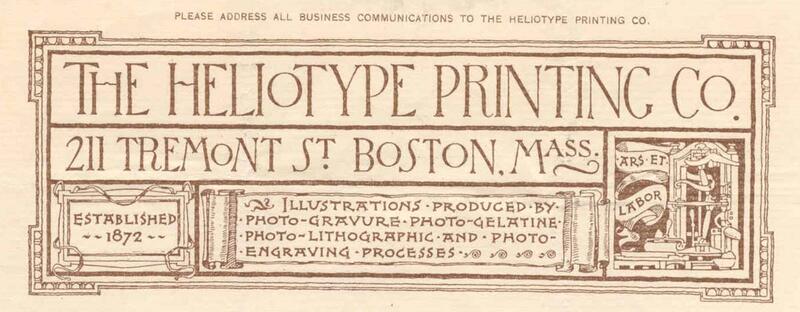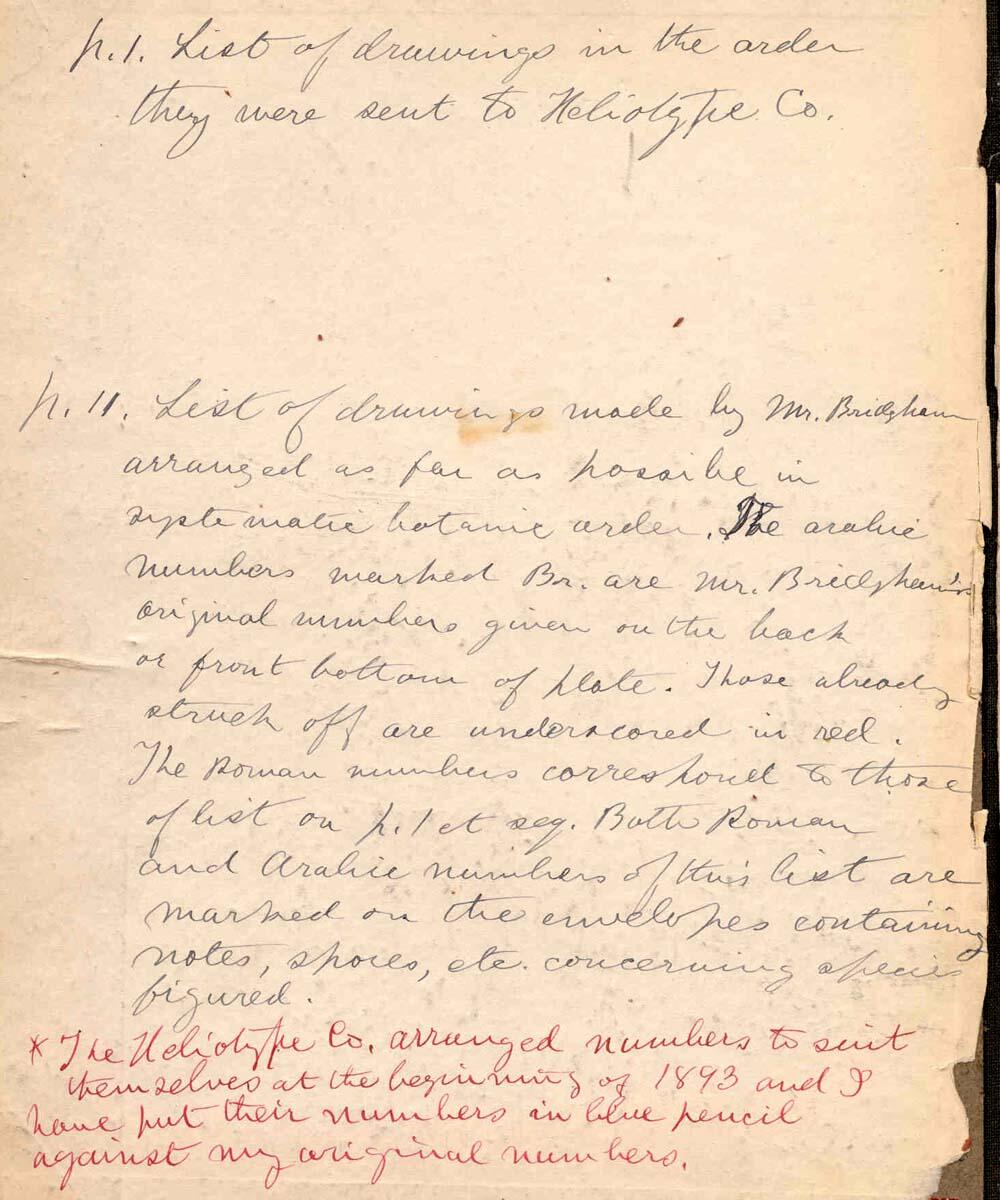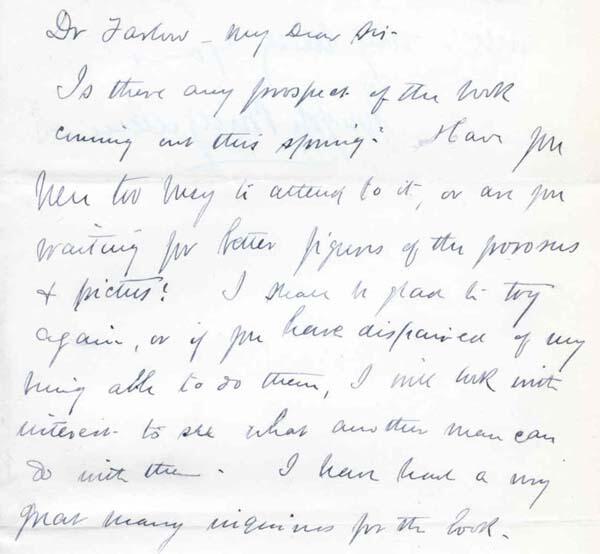 Farlow worked with Mr. Donald Ramsey, the head of the Boston Heliotype Printing Company (BHPC), on producing the lithographs to be used in the Icones. The BHPC had never produced plates like these before but were very interested in the work and an agreed to attempt it.
Farlow worked with Mr. Donald Ramsey, the head of the Boston Heliotype Printing Company (BHPC), on producing the lithographs to be used in the Icones. The BHPC had never produced plates like these before but were very interested in the work and an agreed to attempt it.
The art of lithography was invented by Alois Senefelder in 1798 in Austria. Previous to its creation, color was a time consuming affair with various techniques involved, but all required the hand labor of inking plates individually. Lithography is the process of printing by placing ink on a series of metal or stone ("lithos") carvings which are really reliefs of color regions on the print. Multiple stones are used, one for each color, and the print goes through a printing press as many times as there are stones. The problem for the printers was keeping the image in register, making sure that it would be lined up exactly each time it went through the press so that each color would be in the correct position and the overlaying colors would merge correctly. Part of the allure to the Farlow plates are that they were among the best examples of this process of any ever produced.
Farlow delivered Bridgham's first set of plates to the BHPC in 1891 and Ramsey worked one-on-one with Farlow to help make them as accurate to the drawings as possible. Unfortunately Mr. Ramsey died suddenly. The rest of the BHPC staff tried to maintain the standards set by Ramsey but a problem arose.
The problem occurred in late 1892 when the BHPC assigned a set of numbers to the lithographs they had produced. Unfortunately, each drawing already was represented by an Arabic number that Bridgham had assigned. Farlow kept careful track of where each plate was by this Arabic number and the species name in a small notebook. This was essential as items were constantly moving back and forth between Bridgham's studio in Providence, Farlow's office in Cambridge, the BHPC in Boston, and the Cambridge Safety Vaults Company.
This number was also put on all of the specimens, notes, and photographs corresponding to each plate so that all of the information regarding each fungus could very easily be pulled together.
 The new numbering system that the BHPC assigned made a complex undertaking even more difficult. As of 1893 Farlow's records indicate that there were ten boxes of drawings in storage or at his home with drawings for approximately eight to ten mushrooms per box [9]. Farlow's solution was indicated in his notebook (at left). He recorded the BHPC number next to the original Arabic numbers for each of the completed lithographs.
The new numbering system that the BHPC assigned made a complex undertaking even more difficult. As of 1893 Farlow's records indicate that there were ten boxes of drawings in storage or at his home with drawings for approximately eight to ten mushrooms per box [9]. Farlow's solution was indicated in his notebook (at left). He recorded the BHPC number next to the original Arabic numbers for each of the completed lithographs.
Today each plate has a confusing set of at least 4 or 5 numbers:
- a Roman numeral indicating in what order it was sent to the artist
- an Arabic number assigned by the artist
- A BHPC number
- a plate number from the finished Icones
- numbers assigned to the photographs of the original specimen.
After this the work progressed quietly and at a steady pace for the next few years. In 1896 Farlow retired from undergraduate teaching at Harvard and in January of 1900 he married Lilian Horsford who later was instrumental in getting Icones Farlowianae published.
There is not much correspondence dealing with the book during these years. In 1898, however, Bridgham stopped working for Farlow. It is unclear why Farlow decided to take a break from the book. It is possible Farlow was occupied with issues surrounding the settling of his father's estate and his upcoming marriage but no written explaination exists. In 1898 Bridgham sent his final batch of illustrations to Farlow and the last mention of his working for Farlow occurred in August 1898 [10].
One of Bridgham's final letters to Farlow is from February 28, 1899. He states:

Is there any prospect of the book coming out this spring? Have you been too busy too attend to it, or are you waiting for better figures of the porosus and pictus? I shall be glad to try again, or if you have despaired of my being able to do them, I will look with interest to see what another man can do with them. I have had a very great many inquiries into the book [11].
Unfortunately none of Farlow's correspondence to Bridgham is available and so there is no record of his response to this offer.
Bridgham's last letter to Farlow, dated October 28, 1899, does not do much to clear up the mystery. It appears that Farlow told him of his upcoming marriage and Bridgham offers him heartfelt congratulations, and again refers to the species he felt he was unable to capture. He states "I have a feeling that you are delaying the publication until you can get a better picture of these two representative species." [12]. However, this is not the last word. In 1901 in a letter to Dr. Thaxter Farlow mentions going to Providence to talk to Bridgham [13]. No mention is made of the purpose or outcome of this meeting and in June of 1902 Farlow hired L.C.C. Krieger as his new artist.

On June 1, 1901 L.C.C. Krieger wrote a letter of introduction to Dr. Farlow and included some photographs of watercolors he had done. It is unclear if Farlow was actively seeking a new artist to continue work on the Icones at this time or not. Whatever the circumstance, Farlow was interested and, after viewing some of Krieger's watercolors, they came to an agreement.
On June 6, 1902, almost exactly one year from their initial contact, Krieger sent Farlow a formal letter of acceptance. The salary they agreed upon was $1,200 per year and Krieger promised to arrive in Cambridge in time to start work on July 1, 1902 [14].
Krieger worked with Farlow from 1902 until 1911 illustrating over 340 different fungi. During this time Farlow worked closely with Krieger on the plates and collected supplemental materials and notes as well. In 1906 Farlow asked a colleague, Charles H. Peck (1833-1917), with whom he had been corresponding regarding the identification of specific species, to look over the completed lithographs with him [15]. Because of other demands on his time however Farlow did not begin to work on the accompanying text.
On June 3, 1919 Professor William Gilson Farlow died after a brief and unexpected illness. Only a few weeks before he had written to Thaxter about Herbarium business that he would need to work on once he was well again. Unfortunately he died without finishing his Icones or indicating a plan of action for finishing the work. At the time of his death the only completed text found was a preface written in the 1890's prior to Krieger employment and copious amounts of notes.
Farlow left 500 copies of 103 plates ready for binding. The cost of producing each plate was between $100 and $250 each, or between $10,300 and $25,750 total [16]. These were kept in storage at the Cambridge Safety Vaults Company in Cambridge, MA. No receipts from this company survived but other receipts from storage vaults that Farlow dealt with indicate that the cost of the space was approximately $50.00 per year. The plates were stored there from from 1893 to 1919 at a cost of $1,300. When this is added to the salaries of Farlow's two artists (approximately $21,350) the total equals $32,950 to $58,000. These numbers become even more startling when analyzed by an on-line inflation calculator. The $32,000 to $58,000 that Farlow spent would be equal to $593,000 to $1,044,000 today [17]. This total does not include any of the work on the unwritten text or binding of the book itself. It is readily apparent why such an ambitious book has not been published since. (For a complete breakdown of the cost of publishing see part 5)